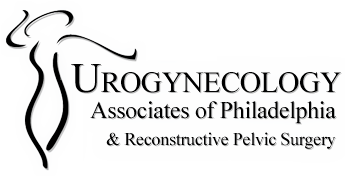Kegel Instructions
It is our strong belief that many problems relating to urinary incontinence and pelvic organ prolapse occur, in part, to weakening or deconditioning of the pelvic floor muscles. This process is typically initiated by pregnancy and vaginal delivery, in addition to life long habits of heavy lifting and strenuous activities. In some cases, pelvic floor weakness can be improved by strengthening the muscles of the pelvic floor. Urogynecology Associates of Philadelphia is proud to offer one of the most comprehensive programs for treating both urinary and anal incontinence. Our providers will initially discuss with you a self directed home program designed to increase awareness of and strengthen the pelvic floor. We also work closely with several physical therapists within Main Line Health who have experience in this field. Additionally, we can offer biofeedback and electrical stimulation therapy for many women who suffer with urinary and fecal incontinence. Our providers have significant experience in working with women following childbirth who develop pelvic floor and core muscle weakness.
Many women are surprised to learn that biofeedback for pelvic floor weakness is covered by most insurers, including Medicare. All patients must first be evaluated by one of our physicians for accurate diagnosis and to determine the appropriateness of therapy. In most cases, a self-directed program of pelvic floor exercises must first be completed by the patient.
Biofeedback Physiotherapy & Pelvic Floor Stimulation for the Treatment of Urinary & Anal Incontinence
Biofeedback physiotherapy adopts a behavioral approach that uses external equipment to demonstrate and alter physiologic events through visual or auditory feedback. Biofeedback therapy is used to improve the strength and endurance of pelvic floor muscle contraction. Studies have shown that biofeedback can improve the symptoms of urinary and fecal incontinence by more than 50% and that clinical improvement can be maintained for up to two years after treatment.
Contemporary biofeedback techniques use sophisticated computerized devices to teach patients how to identify, contract and relax a group of muscles that are important to bladder or anal sphincter control. This equipment uses electroymyography (EMG) to detect the electrical signals produced by the muscle fibers. Biofeedback devices detect these signals through a small tampon-like sensor that is self-inserted into the vagina.
At Urogynecology Associates of Philadelphia, we use sophisticated equipment specifically designed for pelvic floor therapy. We frequently use electrical stimulation therapy to facilitate the biofeedback response by enhancing patient awareness of anal sphincter and puborectalis contraction and to increase muscle endurance.
Biofeedback for the Treatment of Urinary Incontinence
The use of biofeedback for the treatment of urinary incontinence is not a new idea. Dr. Arnold Kegel used a pressure feedback device in the 1940’s to teach his patients how to strengthen their pelvic muscles. Kegel exercises have continued to be recommended over the years, though often without the benefit of biofeedback training, and unfortunately, frequently without the success originally reported by Dr. Kegel.
The most common mistake that women make when performing Kegel Exercises is contracting their abdominal (aka stomach) and gluteal (aka buttocks) muscles instead of their puborectalis muscle. With biofeedback, patients can learn to stop using these muscles and to start using their pelvic muscles properly. This information can then be used to plan a personal exercise program to gradually increase the strength and endurance of the pelvic muscles that control with urination.
Biofeedback & Post Partum Incontinence
Up to 13% of women may experience altered fecal continence after a vaginal delivery. Symptoms of fecal incontinence, including fecal urgency, soiling or involuntary leakage of flatus, occur most frequently in women who sustained trauma to the anal sphincter during vaginal delivery. Biofeedback therapy has been shown to be an effective treatment for postpartum fecal incontinence. Our program includes the use of a small anal probe to improve anal sphincter and pelvic muscle strength through biofeedback as well as the use of electrical stimulation to improve muscle endurance. Clinical studies have supported the effectiveness of biofeedback in treating this condition.
Percutaneous Tibial Nerve Stimulation (PTNS)
TNS is a new non drug, Non surgical treatment for Overactive Bladder. It has been used in clinical practice since 2003, and recently has received approval and coverage from Medicare as an alternative treatment for OAB. It also covered by commercial insurers such as Aetna and United. Our office can call your insurance to check on coverage issues.
Urgent PC Neuromodulation System is a combination of a hand-held stimulator, and a thin needle electrode that is insertedunder the skin near the ankle. The stimulator generates a gentle electrical impulse to stimulate the nerve along your leg and to the nerves in your pelvis that control bladder function. This process is also referred to as neuromodulation. Treatment sessions are weekly for 30 minutes each. 60-80% of patients see a satisfactory improvement in their symptoms. Urgent PC may work, even if other treatments, such as medicine, has failed. Clinical response may be seen in as early as two weeks, however it usually takes 5-7 weeks for symptoms to improve.

